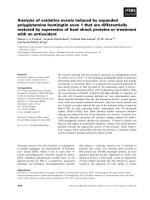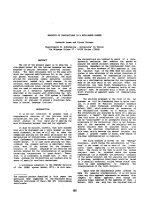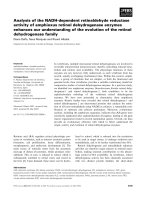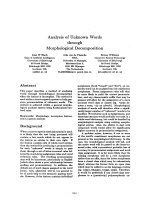báo cáo khoa học: "Analysis of Gg-158(C®T) polymorphism in hemoglobin E/b-thalassemia major in Southern China" pps
Bạn đang xem bản rút gọn của tài liệu. Xem và tải ngay bản đầy đủ của tài liệu tại đây (316.33 KB, 2 trang )
LETT E R TO THE EDITOR Open Access
Analysis of
G
g-158(C®T) polymorphism in
hemoglobin E/b-thalassemia major in
Southern China
Rong Rong Liu, Ming Yue Wang, Yong Rong Lai
*
Abstract
Background: The
G
g-158(C®T) polymorphism plays important function in the clinical variability of HbE/b-
thalassemia. There is little known about
G
g-158(C®T) polymorphism in HbE/b-thalassemia major in Southern China.
This study aimed to explore the association between HbE/b-thalassemia major and this polymorphism in Southern
China.
Methods and Results: The frequency of the
G
g-158(C®T) polymorphism has been evaluated in 32 patients with
HbE/b-thalassemia major from Southern China. Further analysis of the
G
g-158(C®T) polymorphism revealed the
prominent frequency of this polymorphic pattern among HbE/b-thalassemia major patients (65.63%). The presence
of this polymorphis m was strongly correlated with the increase of HbF synthesis.
Conclusions: The frequency of the
G
g-158(C®T) polymorphism was relatively high in Southern Chinese patients
with HbE/b-thalassemia major, often accompanying with high production of HbF. This feature appears to be
different with reports in other races and regions.
To the Editor
Hemoglobin E/b-thalassemia(HbE/b-thalassemia) is a
common form of severe thalassemia syndromes in the
Southern Chinese provinces [1]. Clinical manifestations
of these patients range from nearly asymptomatic to
severe b-thalassemia disease. The
G
g-158(C®T) poly-
morphism (-158 Xmn I
G
g-globin polymorphism) has
been shown to be associated with the increased produc-
tion of HbF and can stro ngly influence this heterogene-
ity of HbE/b-thalassemia [1-6]. The condition of the
- 158 Xmn I
G
g-globin polymorphism has been rarely
reported in HbE/b-thalassem ia majors from Southern
China. The present study was to investigate the fre-
quency of the -158 Xmn I
G
g-globin polymorphism and
its association with high HbF level in HbE/b-thalassemia
major patients of the Southern Chinese.
The clinical data were collected from 32 patients with
HbE/b-thalassemia major who were seen at the First
Affiliated Hospital, GuangXi Medical University. We also
collected data from and compared w ith 30 unrelated
healthy individ uals. Table 1 shows the existence of the
- 158 Xmn I
G
g-globin polymorphism among HbE/b-
thalassemia major and healthy controls. The frequency
of polymorphism in HbE/b-thalasse mia major (65.63% )
was significantly higher than those in healthy controls
(P < 0.00). In these patients, there were 6 b-thalas se-
mia mutations detected in trans to the bE-thalassemia
mutation. None of a-thalassmeia and homozygote of
the -158 Xmn I
G
g-globin polymorphism were found
in all samples. Fig 1. displays the association between
the -158 Xmn I
G
g-globin polymorphism and HbF
level among the HbE/b-thalassemia major. The HbF
level in Xmn I +/- group was more th an that in Xmn
* Correspondence:
Department of Hematology, First Affiliated Hospital, Guangxi Medical
University, China
Table 1 Existence of the -158 Xmn I
G
g-globin
polymorphism among 32 HbE/b -thalassemia major and
30 healthy controls
Polymorphism Controls (%) HbE/b-thalassmeia (%)
-158 Xmn I
G
g-globin 1 (3.33) 21 (65.63)
Xmn I +/+ 0 (0) 0 (0)
Xmn I +/- 1 (3.33) 21 (65.63)
Xmn I -/- 29 (96.67) 11 (34.37)
Liu et al. Journal of Hematology & Oncology 2010, 3:29
/>JOURNAL OF HEMATOLOGY
& ONCOLOGY
© 2010 Liu et al; licensee BioMe d Central Ltd. This is an Open Access article distributed under the terms of the Creative Com mons
Attribution License (h ttp://creativecommons.org/licenses/by/2.0), which permits unrestricted use, distribution, and reproduction in
any medium , provided the original work is properly cited.
I -/- group, confirming the significant difference
between these two groups. The analysis by Spearman
correlation indicated that the - 158 Xmn I
G
g-globin
polymorphism was associated with increased HbF
systhesis (r
p
= 0.588).
In HbE/b-thal assemia, particularly in the major cases,
during hematopoietic stress, point mutation at G-gamma
promoter (the -158 Xmn I
G
g-globin polymorphism) can
induc e high gamma chain production rate [7]. The heavy
hematopoietic stress from severe anemia may thus leads
to the high frequency of this polymorphism in Southern
Chinese patients with HbE/b-thalassemia major. This is
the first report of the frequency of the - 158 Xmn I
G
g-
globin polymorphism in patients with HbE/b-thalassemia
major in Southern China. These data suggest that screen-
ing of the -158 Xmn I
G
g-globin polymorphism and HbF
level in early childhood may help on the management of
HbE/b-thalassemia major patients and possibly prevent
severe complications in Southern China.
Acknowledgements
We are grateful to the investigators, Wei-Xiong Lin, and Yi-Dan Liang, Xuan
Xiao for their technical assistance. This work was surported by grants from
the National Natural Science Foundation of China (No. 30860307).
Received: 22 August 2010 Accepted: 7 September 2010
Published: 7 September 2010
References
1. Olivieri NF, Muraca GM, O’Donnell A, et al: Studies in haemoglobin E beta-
thalassaemia. Br J Haematol 2008, 141:388-97.
2. Fucharoen S, Siritanaratkul N, Winichagoon P, et al: Hydroxyurea increases
hemoglobin F levels and improves the effectiveness of erythropoiesis in
beta-thalassemia/hemoglobin E disease. Blood 1996, 87:887-92.
3. Gilman JG, Huisman TH: DNA sequence variation associated with
elevated fetal G gamma globin production. Blood 1985, 66:783-7.
4. Thein SL, Wainscoat JS, Sampietro M, et al: Association of thalassaemia
intermedia with a beta-globin gene haplotype. Br J Haematol 1987,
65:367-73.
5. Dedoussis GV, Mandilara GD, Boussiu M, et al: HbF production in beta
thalassaemia heterozygotes for the IVS-II-1 G– > A beta(0)-globin
mutation. Implication of the haplotype and the (G)gamma-158 C– >T
mutation on the HbF level. Am J Hematol 2000, 64:151-5.
6. Nuntakarn L, Fucharoen S, Fucharoen G, et al: Molecular, hematological
and clinical aspects of thalassemia major and thalassemia intermedia
associated with Hb E-beta-thalassemia in Northeast Thailand. Blood Cells
Mol Dis 2009, 42:32-5.
7. Thein SL, Menzel S: Discovering the genetics underlying foetal
haemoglobin production in adults. Br J Haematol 2009, 145 :455-67.
doi:10.1186/1756-8722-3-29
Cite this article as: Liu et al.: Analysis of
G
g-158(C®T) polymorphism in
hemoglobin E/b-thalassemia major in Southern China. Journal of
Hematology & Oncology 2010 3:29.
Submit your next manuscript to BioMed Central
and take full advantage of:
• Convenient online submission
• Thorough peer review
• No space constraints or color figure charges
• Immediate publication on acceptance
• Inclusion in PubMed, CAS, Scopus and Google Scholar
• Research which is freely available for redistribution
Submit your manuscript at
www.biomedcentral.com/submit
Figure 1 The difference of HbF level in Xmn I +/- group and
Xmn I -/- group among the HbE/b-thalassemia major. The HbF
level in Xmn I +/- group is obviously higher than in Xmn I -/- group
(* P<0.01).
Liu et al. Journal of Hematology & Oncology 2010, 3:29
/>Page 2 of 2









